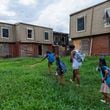A few years ago, our carpool fell through and my wife and I were faced with a pressing problem: Who would drop everything at our full-time jobs each afternoon to pick up our three sons from grammar school?
It was a no-win decision because it meant carving a chunk from the workday, fighting traffic to get to Decatur and then chauffeuring them home. (This was Catholic school, there’s no yellow buses.)
We made an easy choice: “Fellows, ever hear of MARTA?” The boys could walk a few blocks to the courthouse and grab the 19 bus. The ride home was a straight shot and, we figured, would give them some adventure, independence and responsibility.
When some other parents heard of our scheme, you’d have thought we were teaching them knife fighting.
“Is that safe?” we were asked.
“Well, I like their chances,” I’d respond.
Thankfully, no one reported us to DFACS and they are still alive and are in high school and college.
I thought about this a few weeks ago visiting the University of Chicago, where one of our young MARTA riders is a freshman. At a presentation for parents, the topic of student resilience came up and, it turns out, they’re increasingly not.
The subject of how kids who grew up bubble-wrapped now deal with adversity is a cause célèbre at the University of Missouri and Yale. At those fine institutions, angry, finger-pointing students complain about a lack of “safe spaces” on campus — locations where they can remain snug, secure and tucked away from the anxiety, aggravation and worry this world might provide.
“I find it interesting that the word of choice is ‘safe,’ because safe is the brass ring of American society,” said Lenore Skenazy, a former newspaper columnist who caused a stir when she wrote about letting her 9-year-old take the subway home alone in New York City.
She now runs Free Range Kids, a website devoted to the horrors wrought by a generation of helicopter parenting.
“It doesn’t surprise me they feel nothing is safe by the time they get to college because they’ve been told for their first 18 years they are constantly in danger,” Skenazy said. “A lot of it comes from the idea of never letting our kids have unsupervised time. Any time there is something upsetting, there’s an authority figure you can turn to and they will settle it or figure it out for you.
“They grew up in a maelstrom of worry. We live in one of the safest times in human history. (This is a) society that almost hallucinates danger.”
Hello, safe space. I need a fluffy pillow.
Safety for our children is both physical (we’re forever terrified of the ever-lurking Stranger Danger) and psychological (we worry exposure to hurtful words or actions may damage their carefully nurtured self-esteem.) That’s why my kids got shelves of trophies, even though their teams rarely, if ever, won championships.
The subject, while not new, has become a constant buzz. In September, Atlantic Magazine’s cover story was “The Coddling of the American Mind.”
“In the name of emotional well-being, college students are increasingly demanding protection from words and ideas they don’t like,” the authors wrote. “Here’s why that’s disastrous for education—and mental health.”
Last month, I attended parents’ weekend at the University of Chicago, and the head of the school’s student health and counseling program spoke about a program he designed to teach students about building resilience.
Alex Lickerman, a physician who wrote “The Undefeated Mind: On the Science of Constructing an Indestructible Self,” said the art of bouncing back from adversity is not innate. It’s a learned trait. One must learn to set expectations, endure disappointment, take personal responsibility and even manage pain, physical or psychological.
After his presentation, he asked for questions. I noted he had observed and helped students at this top-flight university for 20 years. So what kind of trend did he see with them?
Lickerman leaned forward, smiled broadly and said he was glad I asked. The question unleashed a fountain within him. Students, he said, increasingly find it hard to recover from middling troubles and even minor irritations.
“Parents have not allowed their children to fail and don’t have high expectations for their kids on handling failure,” he said.
I called him this week to expand on his thesis.
“In the past 10 to 20 years everyone has become fragile,” he said. “We have to be careful about what we say. This generation is so easily offended.”
Why is this? Parents, he responded. They’ve toiled mightily to prevent their darlings from experiencing the bitter taste of failure or unpleasantness. Part of it is the Mother Hen Syndrome. I mean, who likes to see their kid bloody or walking back to the dugout dejectedly after striking out? Part of it is parents managing their own worry concerning their kids, so they pave the way to make them succeed and assuage any latent guilt.
Parents increasingly inject themselves into all facets of their kids’ lives, even when the offspring is time zones away. Lickerman sees students devastated after earning their first “C.” Time was, such an event was a wake-up call, a message telling a student to skip the bars and find the library. Today, it brings frantic parental calls or school visits to make things right.
(A friend who’s an administrator at a local university calls such parents “stealth fighter parents. They don’t hover like helicopters, they swoop in to school to take care of them.”)
“I think kids need to know how to get up when they’re knocked down,” said Lickerman. “But the only way you can learn that is to get knocked down. If they don’t succeed, they can go forward and figure out what happened.”
Lickerman’s advice is fairly simple: Allow your kids to struggle as far as you think they can — and then perhaps a little more — and try to let them figure it out for themselves. They just might surprise you.






